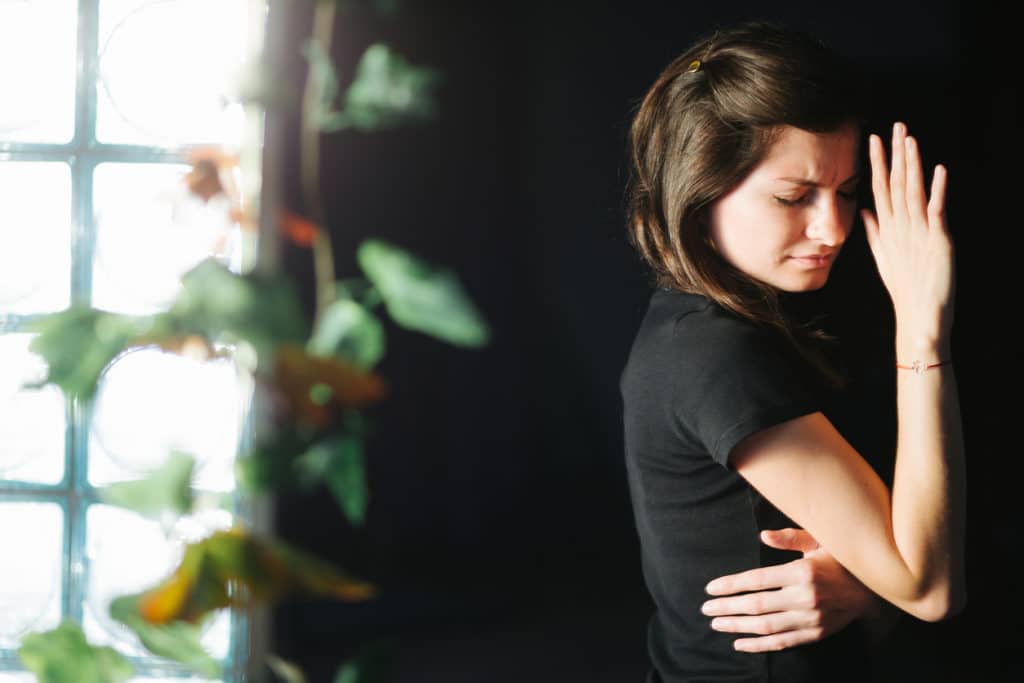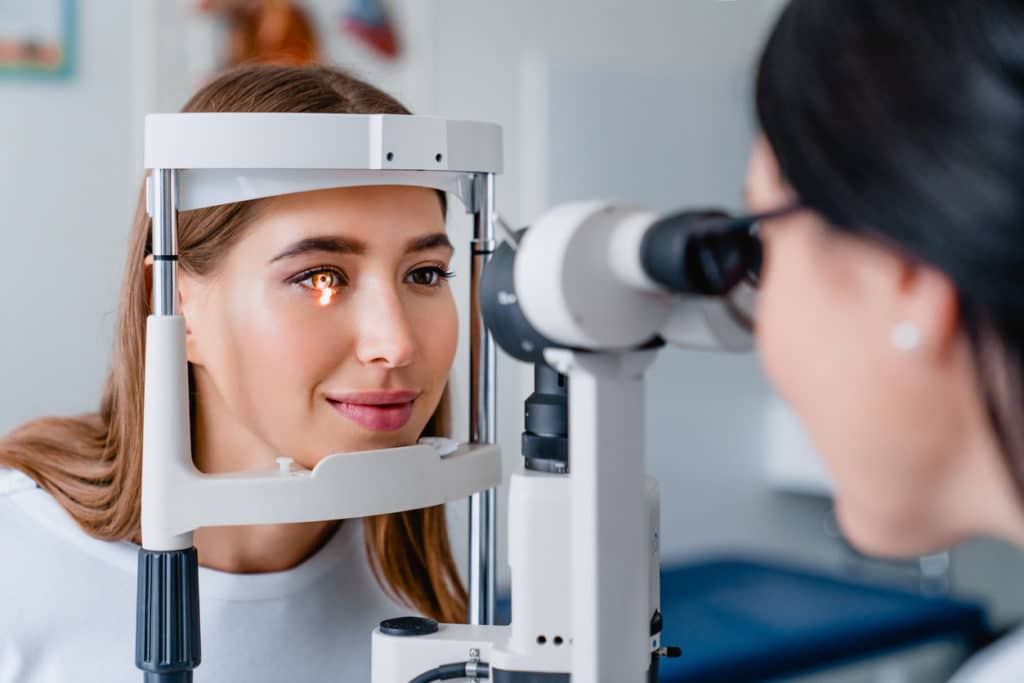
Reviewed and updated for 2024 by Molly Duong, M.D.
Photophobia is the medical term describing sensitivity to light. This condition can be episodic – such as being exposed to light in the early morning after opening the curtains – or chronic, in which the symptoms extend for long periods.
Table of Contents
What Causes Photophobia?
Photophobia can be caused by brain disorders, pre-existing eye conditions, lighting, or even a reaction to medication. When exposed to indoor lighting or sunlight, people with photophobia experience discomfort, irritation, and sometimes pain.
What makes your eyes sensitive to light?
There are many conditions that can make a person more sensitive to light than others. An important thing to note is that photophobia is not an illness in itself, but a symptom of a related disease. Despite this, some people can experience photophobia without any underlying conditions.
For instance, if you have chronic migraines, your eyes are more susceptible to experiencing sensitivity to light. Up to 80% of people with migraines experience photophobia when under a migraine attack.
People with lighter iris colors also tend to experience more sensitivity to light compared to people with darker irises. This happens because people with darker irises have more pigmentation to protect them from the glare of light.
Although discomfort and irritation are the primary symptoms of photophobia, you can also experience:
- Difficulty reading
- Seeing bright spots, even when your eyes are closed
- Forehead pain
- Tearing
- Squinting
- Dry eye symptoms
- Lightheadedness
For a majority of sufferers, photophobia will be accompanied by headaches, fatigue, or sometimes nausea.
Common Conditions That Cause Photophobia
Eye illnesses
Eye conditions are the largest triggers for light sensitivity after migraines. Whenever eye-related illnesses cause light sensitivity, one may experience irritation, pain, and redness in the eyes. Here are some common eye-related conditions that cause photophobia.
Dry eyes – People with dry eyes often have trouble maintaining an adequate tear film. . This can create an irregular ocular surface, altering the way the eye receives light signals. This can lead to increased discomfort with viewing light.
Dilated pupils – Dilated pupils are an abnormal pupil state often resulting from medication side effects, eye injuries, or brain injuries/trauma. Dilated pupils do not react to light like normal pupils do. Pupils usually contract when exposed to light to prevent excess light from entering the eyes. Individuals with dilated pupils thus get more light into their eyes, increasing sensitivity.
Corneal trauma – Cornea trauma happens when the clear, protective cover of the eye, the cornea, is scratched or damaged. This can occur when foreign bodies such as dust and wood shavings get into the eye and injure the cornea, or through direct trauma itself. Corneal trauma can distort the ocular surface, and with the accompaniment of pain, can lead to sensitivity to light
Uveitis – Uveitis is a type of inflammation in the eye. Symptoms include blurred vision, pain, redness, and photophobia. True uveitic episodes require immediate treatment under an eye doctor’s care.
Cataracts – A cataract is a clouding and/or browning of the lens inside your eye. . This clouding can cause increased sensitivity to light as light becomes more scattered when filtered through the cataract.
Glaucoma – Glaucoma is a condition of the optic nerve that can lead to blindness. Though more prevalent at advanced stages, photophobia can arise at any stage in this disease.
Brain-related Conditions
Meningitis – Meningitis is an inflammation around the brain and spinal membranes caused by bacterial infections. One study found that 88% of children cited light sensitivity as the first symptom of their condition.
Encephalitis – This condition occurs when the brain is inflamed as a result of a viral infection. Because of the disruption in neurological functions that also process vision, people suffering from encephalitis may experience photophobia.
How is Photophobia Diagnosed?

If you have ever found yourself wondering: “why are my eyes sensitive to light?”. If yes, then it’s time to visit your family doctor or an eye doctor (ophthalmologist/optometrist). Your doctors will ask a series of questions to understand your condition better. Some typical questions to expect include:
- Do you have any medical conditions, including mental and neurological disorders or chronic illnesses?
- What medication(s) are you taking?
- How long and how often do you experience light sensitivity and migraines?
- Does the light sensitivity cause increased headaches?
Your doctor will then conduct a series of physical and eye examinations to find the root cause of your sensitivity to light. If they are concerned about a neurological link, your doctor may order further imaging.
Your eye doctor will also perform a slit-lamp exam to examine your eyes and the reaction they have to light. This test involves a special microscope with a high-intensity light to diagnose your eye conditions. Sometimes, your doctor may use special drops to dilate your pupils for a better view. This is done in conjunction with a procedure called ophthalmoscopy to examine your entire eye comprehensively.
How to Treat Photophobia
There are two considerations to treating photophobia. First and foremost, the focus lies in treating the underlying conditions, while the second attempts to find relief in treating the light sensitivity itself In most cases, treating an underlying disease leads to the fading of photophobia symptoms. For example, if dry eyes were the primary cause of the sensitivity, patients will notice a reduction in light sensitivity after treating the dryness.
However, if there is no underlying condition and photophobia is the result of using wrong lighting, you can make a few changes to make lighting more comfortable. The treatment of photophobia in these cases should start with controlling your environment, such as with light filters.
Light-filtering glasses
Photochromic lenses
Sometimes referred to as transitions, photochromic lenses turn darker in the presence of UV. Photochromic lenses can help protect you from bright sunlight and reduce photophobia.
Polarized sunglasses
The polarization feature serves to reduce glare from the sun, headlights, and reflections off water. For people who spend a lot of time outdoors, polarized lenses can make drastic improvements in visual quality of life.
Prosthetic contact lenses
These contact lenses are often a last resort option for individuals with severe light sensitivity, such as in people with albinism. Prosthetic contact lenses reduce the amount of light entering the eye through their tinted design. These special contact lenses have to be prescribed by your eye doctor.
Are there downsides to wearing tinted glasses all the time?
Wearing tinted glasses all the time may not be the best solution to dealing with photosensitivity. They can provide a good option for outdoor use, but may cause issues when worn even in dim lighting, such as while indoors. Your eyes can start to adapt to this darkness, making you more sensitive to light over time by decreasing your tolerance threshold.
Instead, a light filter for indoor lighting may be more convenient, as discussed below.
Light filters for overhead fluorescent and led light panels
Research has shown that fluorescent and incandescent lights can contribute to severe headache and light sensitivity. One can use light filters to prevent glare and discomfort from fluorescent lights. Using light filters lets you control the amount of light around you to your liking, and in turn, should decrease light sensitivity and potentially migraines.
Can Anxiety Cause Photophobia?
It’s not yet established whether anxiety can directly cause photophobia. However, research has shown that there are links between anxiety and photophobia. This means that people with anxiety are more likely to suffer from photophobia.
Dr. Bradley from Utah University suggests photophobia is likely to happen to people with mental disorders, including ADHD, anxiety, and panic agoraphobia.
Another aspect to the correlation between anxiety and sensitivity is that one may also develop anxiety known as light sensitivity anxiety when dealing with photophobia. This condition can manifest symptoms of nervousness, light headaches, and panic when bright lights are present.
The Link Between LED Lights and Photosensitivity
There’s no doubt that LED lights bring several benefits to the table. But there’s also a darker side to them that concerns our health. A French ANSES report suggests that intense exposure to blue light in LEDs can lead to ocular damage. LEDs are also a contributing factor to the onset of migraines – a major cause of photophobia.
Since LED lights are found almost everywhere nowadays, many people are more prone than ever due to increased exposure
Signs of Migraines That Aren’t Headaches
Sometimes migraines do not always manifest as a painful headache. This condition of migraine without headache is known as a silent migraine. The silent migraine can last anywhere between 5 to 60 minutes.
Although headaches do not accompany silent migraines, they can affect people’s daily lives and inhibit activities like driving. Furthermore, there is no known cure for silent migraines, making the lives of those affected difficult.
Some common symptoms of silent migraines include:
- Vomiting and an upset stomach
- Dizziness
- Sore jaw/neck
- Sensitivity to smells, lights, and touch
- Flashing lights
Fluorescent and LED lights can exacerbate the symptoms of silent migraines as well. Those suffering from migraines can use light filters to reduce the glare from these light fixtures to assist with their symptoms.
Can You Have Light Sensitivity with Tension Headaches?
Tension headaches are dull pains accompanied by pressure on the sides and back of the head. The cause of tension headaches is not well-known, but the contraction of skull muscles is a likely cause. Stress is also the number one trigger of tension headaches.
Interestingly, tension-type headaches can cause photophobia as well. This is especially common if the person is exposed to LED, incandescent, or fluorescent light. However, people with tension-type headaches often report less sensitivity compared to those with migraines.
NaturaLux Light Filters to Reduce Photophobia
NaturaLux is an easy-to-install light filter that transforms fluorescent and LED lights to natural light. Not only do they remove glare from your room, but they also reduce light sensitivity and eye strain.
NaturaLux light filter works with both fluorescent panels and tubes. They are built to last you at least ten years, while maintaining great energy efficiency throughout
About Dr. Molly Duong
Dr. Molly Duong is a therapeutic and glaucoma certified optometrist. She obtained her doctorate degree at the University of California Berkeley, School of Optometry, and graduated with Honors in Research. Upon graduation, she completed a residency at the Major Charles Robert Soltes Jr. Blind Rehabilitation Center located at VA Long Beach, gaining expertise in primary care, low vision, and traumatic brain injury cases.
She is passionate about expanding innovations in technology and medical devices to improve vision care, and is always looking to build her professional acumen. On top of patient care, she also works in medical writing for ophthalmic trade articles and blogs, as well as consulting for a new vision-based web application in development.
Sources
Seidel, Stefan et al. “Psychiatric comorbidities and photophobia in patients with migraine.” The journal of headache and pain vol. 18,1 (2017): 18. doi:10.1186/s10194-017-0718-1
Amarilyo, Gil et al. “Diagnostic accuracy of clinical symptoms and signs in children with meningitis.” Pediatric emergency care vol. 27,3 (2011): 196-9. doi:10.1097/PEC.0b013e31820d6543
Silent Migraine: A Guide | American Migraine Foundation